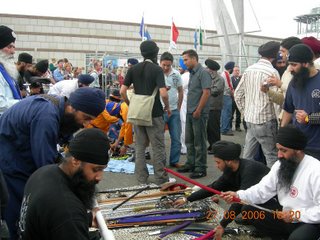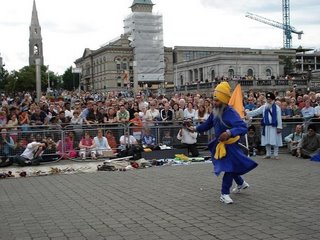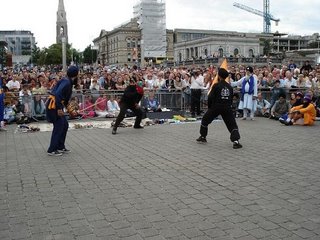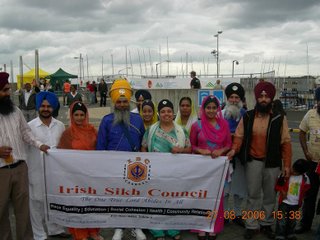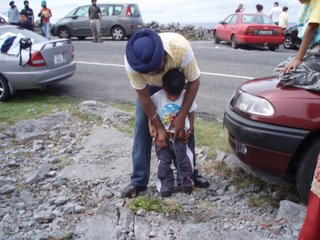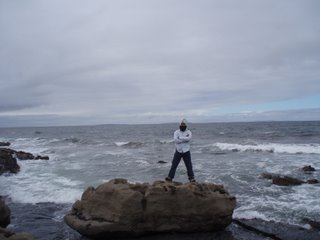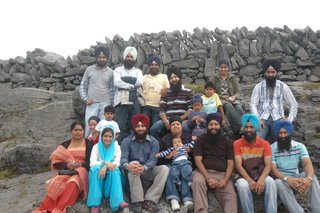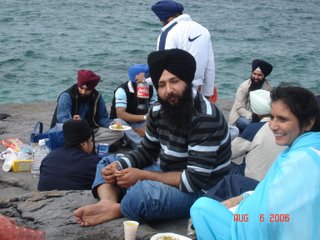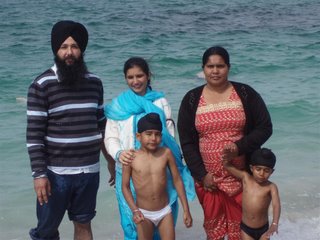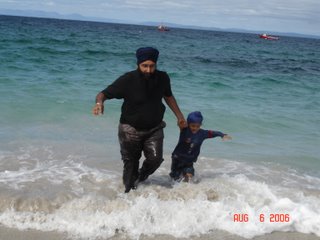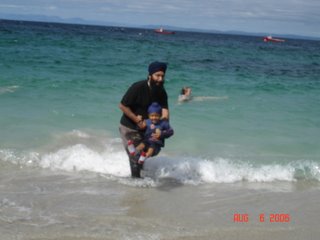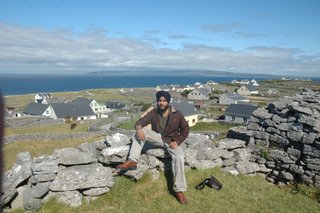| A documentary films that tells about Sikhs and the Turban. There is no download option for this video. If anybody knows how to download, please let me know | |
Thursday, September 21, 2006
Sikhs and Turban - Enjoy!!
Wednesday, September 20, 2006
Why Ireland Has No Snakes?
The fact that there are no snakes in Ireland, gives bit of refief if you go out touring the country side. Back home in India, one of the prime phobia, people used to have was snakephobia! fear of .... rabba kiteh sap na larh jave...used to keep lurking the mind, when people were forced to go out to fields (khet) (at night) to switch on/off tubewells or check water in the fields.
I just came across this article from internet which explains why Ireland has no snacks..including the commonly held myth that St.Patrick drove all the snacks from Ireland!
Legend has it that St. Patrick drove all the snakes from Ireland. Sometime back in the fifth century he stood on a hill, the story goes, and used a staff to herd the slithering creatures into the sea, banishing them for eternity. It's true, aside from zoos and pets, there are no snakes on the emerald isle. In fact, there never were any snakes in Ireland. This state of affairs probably has more to do with the vagaries of geography than any neat tricks performed by St. Patty.
Snakes first evolved from their lizard forebears about 100 million years ago during the late Cretaceous period, about the same time that Tyrannosaurus rex first appeared. Early snakes were small and wormy, resembling modern blindsnakes (suborder Scolecophidia). Ancient snake fossils are found only on southern continents, suggesting that snakes first radiated from Gondwanaland—a former supercontinent comprised of modern-day Antarctica, South America, Africa, India, and Australia. Migrating to Ireland wasn't an option at this time, as the area was completely underwater. The chalky sediments that would eventually become the 700-foot Cliffs of Moher on Ireland's west coast were being laid down at the bottom of the sea.
 During the Cenozoic era, beginning 65 million years ago, the world's climate gradually began to dry out, and vast tracts of grasslands and other open habitats came to dominate much of the northern hemisphere. Large dinosaurs went extinct, opening the door to new groups of animals. By the Eocene epoch, 50 to 35 million years ago, the predecessors of boas and pythons (called the basal Macrostomatans) were widespread throughout the northern hemisphere. Explosive radiation of snakes in the suborder Colubroidae, including vipers and cobras, occurred during the Miocene epoch, 25 million years ago. Now snakes are found in deserts, grasslands, forests, mountains, and even oceans virtually everywhere around the world. Everywhere except Ireland, New Zealand, Iceland, Greenland, and Antarctica, that is.
During the Cenozoic era, beginning 65 million years ago, the world's climate gradually began to dry out, and vast tracts of grasslands and other open habitats came to dominate much of the northern hemisphere. Large dinosaurs went extinct, opening the door to new groups of animals. By the Eocene epoch, 50 to 35 million years ago, the predecessors of boas and pythons (called the basal Macrostomatans) were widespread throughout the northern hemisphere. Explosive radiation of snakes in the suborder Colubroidae, including vipers and cobras, occurred during the Miocene epoch, 25 million years ago. Now snakes are found in deserts, grasslands, forests, mountains, and even oceans virtually everywhere around the world. Everywhere except Ireland, New Zealand, Iceland, Greenland, and Antarctica, that is.
One thing these few snake-less parts of the world have in common is that they are surrounded by water. New Zealand, for instance, split off from Australia and Asia before snakes ever evolved. So far, no serpent has successfully migrated across the open ocean to a new terrestrial home. As the world's oceans have risen and fallen over the millennia, land bridges have come and gone between Ireland, other parts of Great Britain, and the European mainland, allowing animals and early humans to cross. However, any snake that may have slithered it's way to Ireland would have turned into a popsicle when the ice ages hit.
 The most recent ice age began about three million years ago and continues into the present. Between warm periods like the current climate, glaciers have advanced and retreated more than 20 times, often completely blanketing Ireland with ice. Snakes, being cold-blooded animals, simply aren't able to survive in areas where the ground is frozen year round. Ireland thawed out for the last time only 15,000 years ago. Since then, 12 miles of icy-cold water in the Northern Channel have separated Ireland from neighboring Scotland, which does harbor a few species of snakes. There are no snakes in Ireland for the simple reason that they can't get there.
The most recent ice age began about three million years ago and continues into the present. Between warm periods like the current climate, glaciers have advanced and retreated more than 20 times, often completely blanketing Ireland with ice. Snakes, being cold-blooded animals, simply aren't able to survive in areas where the ground is frozen year round. Ireland thawed out for the last time only 15,000 years ago. Since then, 12 miles of icy-cold water in the Northern Channel have separated Ireland from neighboring Scotland, which does harbor a few species of snakes. There are no snakes in Ireland for the simple reason that they can't get there.
Snakes and Myths
So where did the myth of St. Patrick and the snakes come from? Most scholars agree that snakes symbolize paganism, which St. Patrick is also credited for banishing from Ireland. Snakes as symbols of evil are prevalent throughout Judeo-Christian mythology, most notoriously in the Garden of Eden as a tempter of Eve. Other societies have viewed snakes with more favor. Snakes were venerated in ancient Egpyt, and many gods were represented by snakes, such as the cobra goddess Neith, founder of the universe. More recently, Ben Franklin advocated making a rattlesnake the symbol of the United States.
Mythology aside, herpetologists (scientists who study snakes and other reptiles and amphibians) like to point out that snakes play an important role in many ecosystems throughout the world. Snakes benefit humans by controlling rodent populations, and snake venom has been used to treat various diseases, including cancer, heart disease, and hemophilia. Unfortunately, some 200 species of snakes are considered threatened or endangered, the biggest threat being habitat loss resulting from human activities. Unless humans start taking more of an interest in their survival, real-life snakes may find themselves banished from more places than just Ireland.
—Jill Locantore
Wednesday, August 30, 2006
Dun Laoghaire Festival of World Cultures

Bhai Sukhwinder Singh fromUk gave a brief presentation about Sikhism covering core beliefs and cultural part also.
 Audiences - turnout was bit low than what we expected b'cose of location of canteen where talks were organised, but whosoever came were taken care of.
Audiences - turnout was bit low than what we expected b'cose of location of canteen where talks were organised, but whosoever came were taken care of.
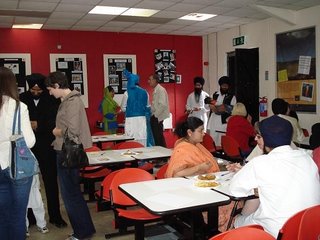 Tea Party with bread & paneer wale pakore.....and discussion!
Tea Party with bread & paneer wale pakore.....and discussion!
(Singh Pakoreya to bina kisse naal kar ke razi nahi)
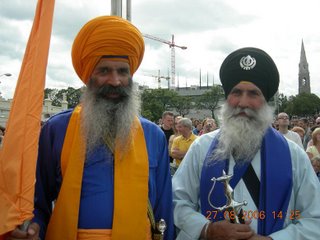 Dhan Guru Dhan Guru de Sikh!
Dhan Guru Dhan Guru de Sikh!Bhai Jarnail Singh jee & Bhai Ragbir Singh jee.
 Rambo and His wife with Bhai Jarnail Singh jee
Rambo and His wife with Bhai Jarnail Singh jee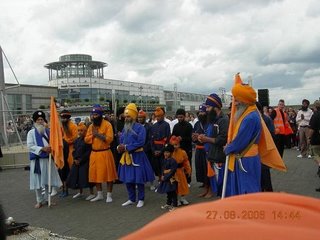
 Bhai Jarnail Singh Jee with Nishan Sahib. On the other side is Bhai Ragbir Singh jee. These three elder Gursikhs (Bhai Jarnail Singh, Bhai Ragbir Singh and Bhai Pritpal Singh jee) were the main attraction for the media and other irish people, who kept on clicking photographs...as if they are from other world!
Bhai Jarnail Singh Jee with Nishan Sahib. On the other side is Bhai Ragbir Singh jee. These three elder Gursikhs (Bhai Jarnail Singh, Bhai Ragbir Singh and Bhai Pritpal Singh jee) were the main attraction for the media and other irish people, who kept on clicking photographs...as if they are from other world! 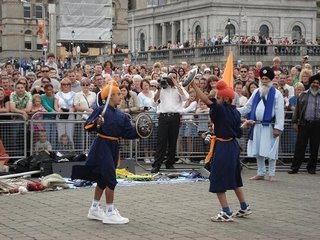 Young Khalsas (from Baba Deep Singh Gakta Akhara, Dublin) performing sword fighting. Ferocity with which these young khalsa's traded swords was just amazing!
Young Khalsas (from Baba Deep Singh Gakta Akhara, Dublin) performing sword fighting. Ferocity with which these young khalsa's traded swords was just amazing!
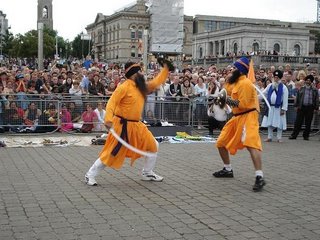 Gudu Veer Jee (R) Vs Gurmeet Singh or 'Gill Bhaji' from Baba Deep Singh Gatka Akhara Dublin.
Gudu Veer Jee (R) Vs Gurmeet Singh or 'Gill Bhaji' from Baba Deep Singh Gatka Akhara Dublin.
Bhai Prithipal Singh (uk) performing with King-Size Tega!
Singh from Baba Ajit Singh Gatka Akhara (Uk) putting up brave face to others singhs.
As the singhs were performing with beats of dhol, more and more people were coming to see the singhs in action. when it was about to finsih, event manager has to stop the gatka demonstration midway, bcose he did not have enough security staff to controll the crowd. people had started to climb the walls erected on sea side!!!!
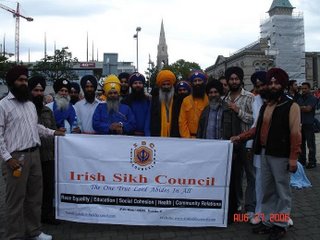 Bhai Sahib from Uk and other Singhs With Irish Sikh Council banner. Majority of Singhs in the picture are active sevadaars in ISC. It just has been bit over two years that ISC is founded, since then it is doing commendable job with Guru Sahib's Kirpa.
Bhai Sahib from Uk and other Singhs With Irish Sikh Council banner. Majority of Singhs in the picture are active sevadaars in ISC. It just has been bit over two years that ISC is founded, since then it is doing commendable job with Guru Sahib's Kirpa.
 Every time Bhai Sahib come to Ireland, most of us feel honorned to see off them! it is really a blessing to have sangat of these Gursikhs.
Every time Bhai Sahib come to Ireland, most of us feel honorned to see off them! it is really a blessing to have sangat of these Gursikhs.
Monday, August 28, 2006
Singh Is King!
Tuesday, August 15, 2006
Trip 2 Galway - Day Two -Burren & Aran Island
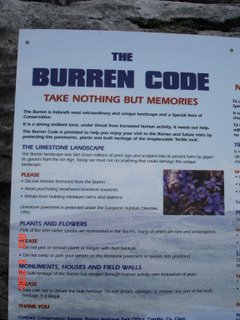
The Burren code is an intiative designed to inform people as to appropriate behaviour when visiting the Burren. The people who live in the Burren depend on the landscape for their livelihoods based on agriculture and tourism. The limestone pavement, flora and built heritage are the resources on which tourism in The Burren thrives. Respecting and conserving this resource will sustain the community’s wellbeing.
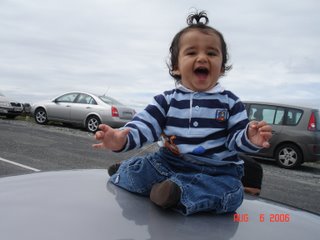 hasda...khelda.....Bodi wala Japnitt
hasda...khelda.....Bodi wala Japnitt 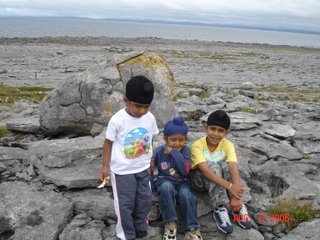 Bharpreet, Sachman, & Gurpreet sitting on rock.
Bharpreet, Sachman, & Gurpreet sitting on rock.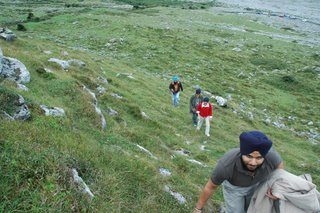 Clibing the hills
Clibing the hills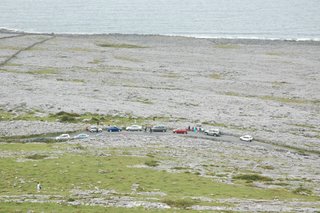 You can see cars parked on the road.
You can see cars parked on the road.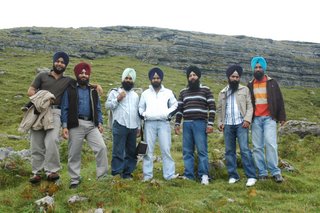 Kirandeep, Hardip, Karanjit, Ranjit, Phulpreet, Gurvinder, & Satwinder, while coming down from top.
Kirandeep, Hardip, Karanjit, Ranjit, Phulpreet, Gurvinder, & Satwinder, while coming down from top.
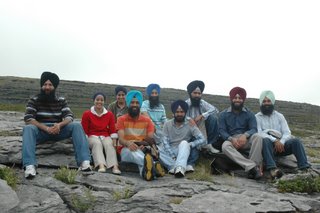 Having Group Photo while sitting on Stones.
Having Group Photo while sitting on Stones.
Here the unfolding layers of limestone form terraces on the slopes of the hills
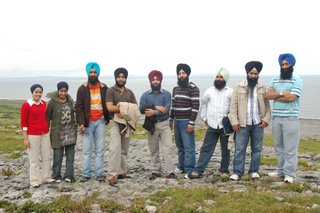 (L2R) Harpreet, Harkiran Kaur, Satwinder, Kirandeep, Hardip, Phulpreet, Karanjit, Gurvinder, Gurmeet Singh
(L2R) Harpreet, Harkiran Kaur, Satwinder, Kirandeep, Hardip, Phulpreet, Karanjit, Gurvinder, Gurmeet Singh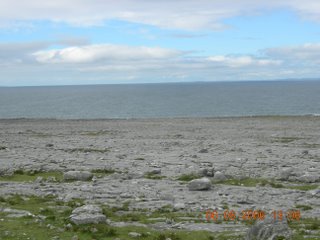 The Burren is a limestone plateau occupying an area of over one hundred square miles in North Clare.
The Burren is a limestone plateau occupying an area of over one hundred square miles in North Clare.

Pani naal takkar lainde hoye! Kirandeep almost had a bath.
In the picture below...ranjit and hardip running out to save themselves.
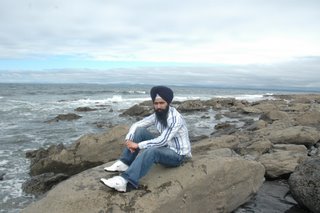 Bhai Gurvinder Singh jee
Bhai Gurvinder Singh jee  Coming back to road - Bhai sahib leading the battalian
Coming back to road - Bhai sahib leading the battalian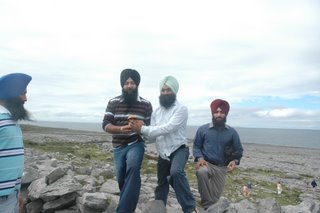 Runner up prise! Rab jane ke...where did he get coloured mushroom?
Runner up prise! Rab jane ke...where did he get coloured mushroom?
Family Photograph!
after so much adventure, everybody was sahi -salamat
Then we drove to ferry port. we reached there at exactly 2pm and ferry was about to leave. Took tickets immediately and went upto ferry staff to ask them to wait for few mintues as some of us were still finding the place for parking. As everybody came we boarded the ferry and set off to aran island.
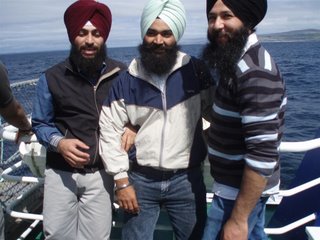 Hardip, Karanjit and Phulpreet Singh
Hardip, Karanjit and Phulpreet SinghFerry was very small and was shaking very badly
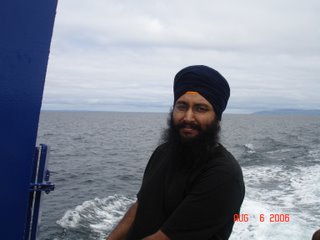 Bhai Harpreet Singh
Bhai Harpreet Singh
Aran Island is 14 kms in length and 3.8 kms in width. Aran is a walker's paradise. Aran is full of wildlife and has some 437 varieties of wild flowers. One can hire a bike or take a pony and trap, or a guided tour with a modern minibus, from the pier. Alternatively,you can also see Aran on horseback alongwith live commentry!
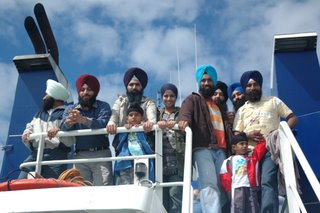 Taking pictures on ferry wasn't easy.
Taking pictures on ferry wasn't easy.
 Harkiran with Japnitt & Jaskiran Bhabi jee.
Harkiran with Japnitt & Jaskiran Bhabi jee.
As we reached Aran Island, first thing we did, to find a place where we can take lucnch.
 Attention please!
Attention please!Island has a small sandy beach, with Crystal clear water. Water seemed 100% free from pollution.
 Glider in the sky! Aran Island has glider airport! infact very near to where we had our lunch.
Glider in the sky! Aran Island has glider airport! infact very near to where we had our lunch.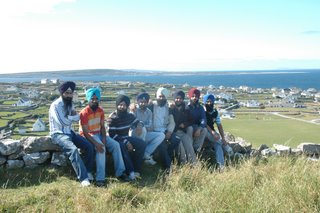 You can see houses in the back. this island has papulation of 1218 in 2006. People depends on fishing for their survival and speak irish language.
You can see houses in the back. this island has papulation of 1218 in 2006. People depends on fishing for their survival and speak irish language.

Morcha fateh!
After that we joined others back our base station and went to take ferry back.
